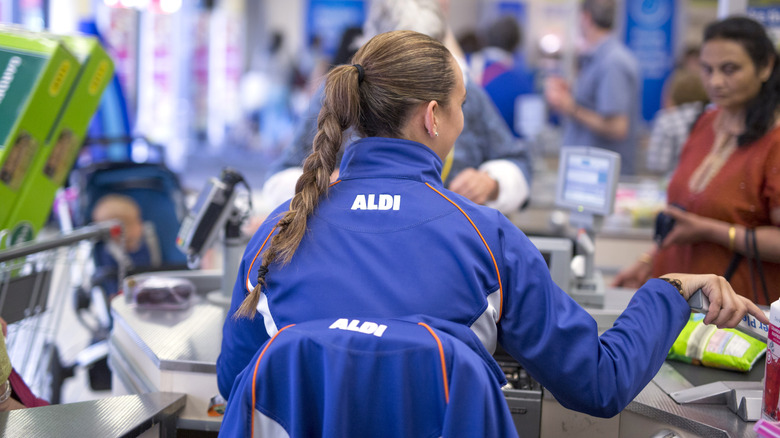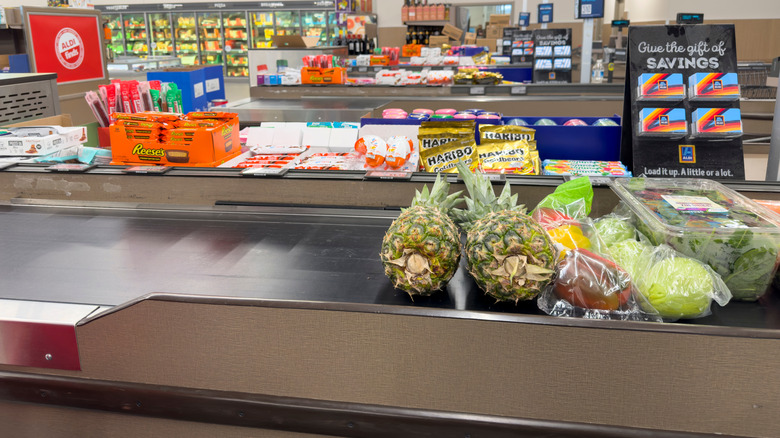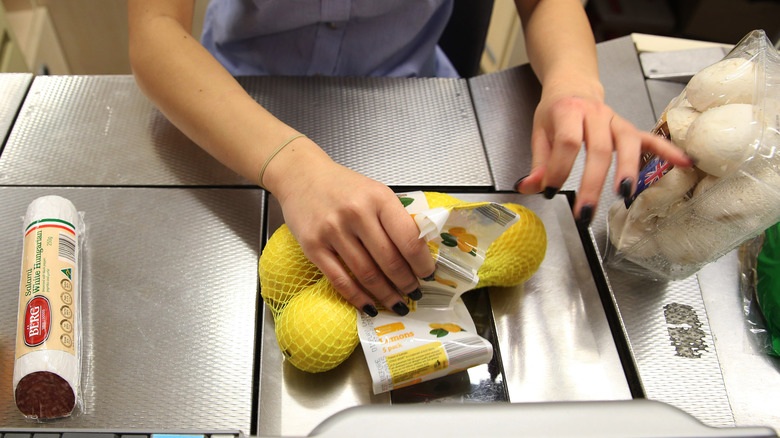The Reason Aldi Cashiers Always Sit Down At The Register While Ringing You Up
Aldi, the German supermarket chain that has developed a cult-like following in America, is obsessed with customer service. From its store layouts to the handy yellow hooks on its carts, the affordable grocer's focus on efficiency extends to the checkout process too.
Many grocery store shoppers who are used to long lines at the checkout and an employee standing as they scan items may be surprised during their first trip to Aldi. For one thing, cashiers are seated at the register during the checkout process and the reason behind it is actually data-proven: It allows them to ring up and execute each transaction faster. "Aldi says that cashiers sit at the register because, according to their testing, it allows us to ring up items faster," Jonah, an Aldi employee, told Mental Floss. "We are given reports at the end of each day for our ringing statistics." The method appears to resonate well with customers, who appreciate the quick checkout experience.
How the Register Maximizes Efficiency
The register itself is built to maximize efficiency and help the employee currently assigned to the register do their job as fast as possible. Of course, there is a standard looking rolling office chair sitting atop a platform with a small lip to keep the chair from falling off. The platform puts the cashier right at cart level, giving them the ability to move your purchase from conveyor belt, to scanner, to cart with the least amount of movement possible.
Underneath the register is a foot rest to help the worker with their posture as they ring you up. Some workers keep one foot on the foot rest, and one on the cart to keep it from moving or from getting taken by a customer. It may seem shocking to see the first time you enter an Aldi, but these are common practices in Europe and parts of Asia.
This is not a perfect system, however. Employees have said that the repeated motion of scanning groceries at that speed has led to them developing carpal tunnel syndrome and other joint issues. One Redditor described it as "hell on the body," and the experience of sitting at the register as very active as opposed to restful. But this is how the groceries are so cheap!
Aldi employees strategize on how to boost their transaction stats
The same way pro athletes might compare batting averages, some Aldi employees share numbers and actively strategize on how to improve them. "Fellow Aldi employees, how do I bring up my boxing/ring speed?" one Reddit post asks. An alleged Aldi shift manager from the Midwest, who said their store's goal is an average of 1,200 items scanned per hour, offered a few tips. First, cashiers should work to simply guide items into the cart instead of picking up each individual item and putting it down in a specific place in the cart.
"There is somewhat of a science to this, as you don't want to be too rough and damage product," the shift manager advised. "However, 90% of customers understand we work very quickly and as long as you aren't putting bread on the bottom of the cart, you should be fine."
Another shift manager encouraged pausing the timer between orders to shave off any down time. For example, if the customer isn't finished loading items onto the belt, pausing and waiting until everything is in place can help the transaction run more smoothly.
"If your customer isn't going to be ready, even for a couple seconds, hit your 1-code right away to stop your timer," the user cautioned. "Waiting 10 [seconds] because the customer hasn't given you the next [cart] or they're asking questions or whatever is time just burned off your speed for something you can't control."
Other ways Aldi is streamlining grocery scanning
Cashiers sitting down at the register as they scan is just one of the tactics to help improve the transaction flow, but there are a couple other Aldi checkout efficiencies designed to get customers in and out as fast as possible. First, shoppers may notice multiple large barcodes on Aldi items. These are helpful so employees don't have to position the item just right in order to scan the barcode and can instead quickly run the product past the scanner without worrying too much about its orientation.
Next, cashiers will often prompt customers to insert their debit or credit cards into the machine before the scanning process is even finished. "Encouraging our customers to pre-insert their card while we are ringing allows the payment process to be near instant, rather than having our customers wait for us to finish ringing and then pull out their card and insert it," Jonah told Mental Floss.



